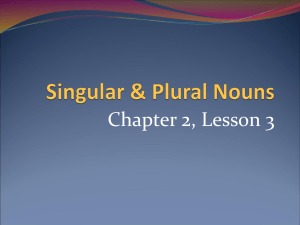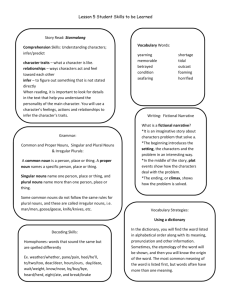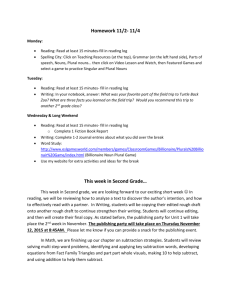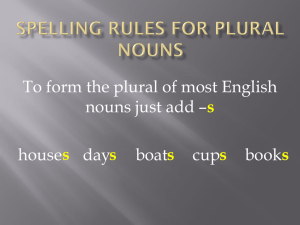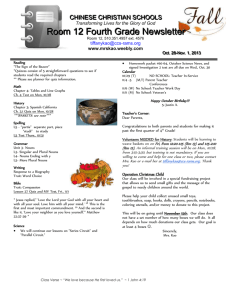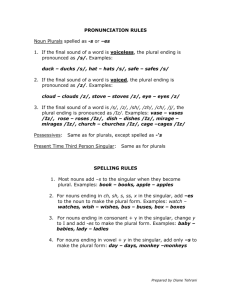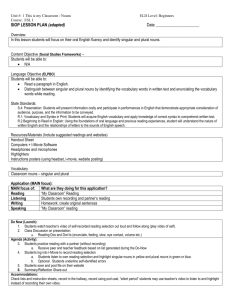Scientific Writing - Universität Tübingen
advertisement
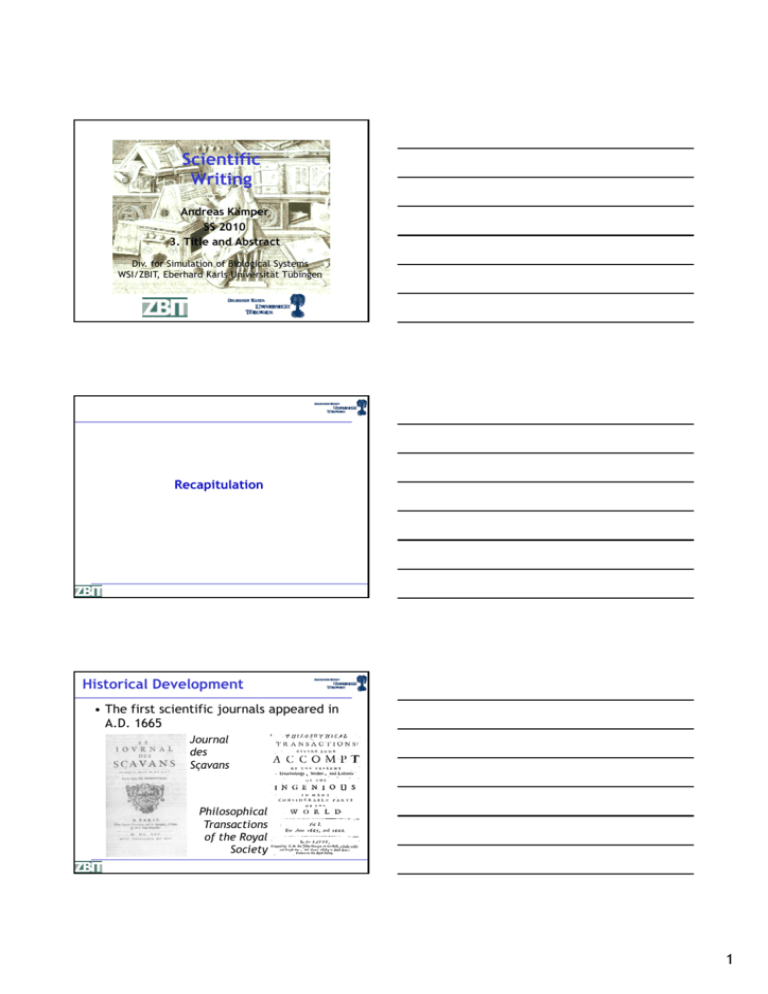
Scientific Writing Andreas Kämper SS 2010 3. Title and Abstract Div. for Simulation of Biological Systems WSI/ZBIT, Eberhard Karls Universität Tübingen Recapitulation Historical Development • The first scientific journals appeared in A.D. 1665 Journal des Sçavans Philosophical Transactions of the Royal Society 1 Standard Structure (I) • Journal space is precious – Reduction of verbosity and of redundancy – Organization of manuscripts in a standard form • The historical development resulted in today’s standard structure: The Introduction, Methods, Results, and Discussion (IMRAD) format Standard Structure (II) • Introduction – What is this all about? Why was this work done? Why do you write this paper? • Materials and Methods – How was the evidence obtained? • Results – What are the facts? What was found? • Discussion and Conclusion – What do your findings mean? Outline • Title • Abstract • Grammar and Style Corner – Plural forms of nouns 2 Title Abstract Style and Grammar Corner Purpose of the Title • What is the paper about? • Properties – Interesting – Concise – Informative • Many, if not most, readers will read the title only and decide on the paper’s relevance for their research on the title alone Length and Style of the Title • The title should be brief – Typically less than 100 characters – Typically less than 10 to 12 words • Choose words with great care • Avoid two part or series titles – Example: Heteropoly Compounds. IV. The Basicities of Some Heteropoly Tungstic and Molybdic Acids and the Charge of Their Anions J. R. Matthews, J. M. Bowen, R. W. Matthews, Successful scientific writing, 2nd Ed., p. 66; example from: E. Matijević, M. Kerker, J. Am. Chem. Soc., 1959, 81(21), 5560–5566. 3 Hints for Selecting a Title • Avoid trivial phrases – – – – – “Notes on …” “A study of …” “Studies on …” “Investigations Investigations on …” “Observations on …” • Avoid articles at the beginning – “A …” – “An …” – “The …” J. R. Matthews, J. M. Bowen, R. W. Matthews, Successful scientific writing, 2nd Ed., p. 66; R. A. Day, B. Gastel, How to write and publish a scientific paper, 6th Ed., p. 40. Hints for Selecting a Title • Do not use uncommon abbreviations • Do not make claims about your findings, be neutral – Do not write “A and B are correlated”, use Correlation of A and B “Correlation B” instead • Do not try to put “a short abstract” into the title When to write the Title? • When starting your research you have a rough “working title” • During writing the paper, collect a number of alternative titles • Finally, Finally select the most appropriate title for the final manuscript 4 Title Abstract Style and Grammar Corner Purpose of the Abstract • Provides an abbreviated but accurate representation of the contents of the entire article – “Summary of the information in a document” – Informative for people who never read the article – Used by secondary sources (e.g. Chemical Abstracts) Types of Abstracts • “Informative” abstract – States the problem, the methods, the principal data and conclusions – A substitute for the paper, “the paper condensed” – For primary research papers! • “Indicative” or “descriptive” abstract – More like a table of contents – Cannot serve as a substitute of the paper – Use for reviews only! 5 Length and Style of an Abstract • Typical length: 250 words – Often a hard limit set by the journal – If you can tell your story in 100 words, do not use 200. Je n'ai fait celle-ci plus longue parce que je n'ai pas eu le loisir de la faire plus courte. I write the present [letter] only longer, because I have no leisure/time to make it shorter. Blaise Pascal Quotation: B. Pascal, Lettres provinciales, Letter XVI, Dec 4, 1656; French text: http://gallica.bnf.fr/ark:/12148/ bpt6k205164n; figure: http://upload.wikimedia.org/wikipedia/commons/7/79/Blaise_pascal.jpg (public domain). Structured Abstracts • Use one paragraph only, unless the journal uses “structured” abstracts Example: S. Böcker et al., BMC Bioinf., 2009, 10(Suppl. 1), S61. Hints on the Abstract • Never put something into the abstract that is not contained in the article • The abstract must be self-contained, often it is published by itself – Do not cite references in the abstract – Do not refer to tables or figures – Do not use uncommon acronyms or abbreviations. Do not use any abbreviation at all, unless you need it several times in the abstract 6 When to write the Abstract? • The abstract should be the last part of the paper you write • Complete everything else; rewrite everything else. Then, at the very end: write the abstract Title Abstract Style Grammar C Corner St l and dG Plural Forms of Nouns (I) • In general (regular plural) – Add an ‘-s’ to the noun table tables, tree trees • If the noun ends in a sibilant sound, i e with ‘-s’ i.e., s , ‘-ss’ ss , ‘-sh’ sh , ‘-ch’ ch , or ‘-x’ x – Add ‘-es’ to the noun class classes, fax faxes Sources: J. Crump, English irregular plural nouns, http://www2.gsu.edu/~wwwesl/egw/crump.htm; K. M. Mallory, Irregular nouns list, http://www.english-zone.com/spelling/plurals.html; and others. 7 Plural Forms of Nouns (II) • If the noun ends with ‘-y’ – If the ‘-y’ follows a vowel – Or if the noun is a proper name • Simply add an ‘-s’ • play plays • The two Germanys united in 1990. – Else • ‘-y’ changes to ‘-ies’ • fly flies, body bodies Irregular Plural Nouns (I) • Nouns that end with ‘-f’ or ‘-fe’ – For some: replace the ‘-f’/‘-fe’ by ‘-ves’ half halves, self selves, wife wives Regular: cliff cliffs, roof roofs • Change of vowels (Old English roots) foot feet, (fire)man (fire)men, louse lice, mouse mice, tooth teeth, woman women • Old English plurals forms retained child children, ox oxen Irregular Plural Nouns (II) • Nouns ending with ‘-o’ – – – – If it’s a short form If it’s the name of peoples If the word originates in another language If a vowel precedes the ‘-o’ o • Simply add ‘-s’ kilo kilos, Navajo Navajos, macho machos, video videos – Else • Depending on the word, ‘-oes’ and sometimes ‘-os’ is correct. If in doubt: use ‘-oes’. 8 Singular and Plural Identical • In some words the singular and plural forms are identical – Chinese Chinese, Japanese Japanese, Swiss Swiss – cod cod,, fish fish ((or fishes), salmon salmon, perch perch, trout trout – deer deer, grouse grouse, moose moose, sheep sheep – offspring offspring, means means, series series, species species Figures top to bottom (all public domain): Atlantic cod, http://en.wikipedia.org/wiki/File:Atlantic_cod.jpg; Coho salmon, …:Oncorhynchus_keta.jpeg; European perch, …:Aborre,_Iduns_kokbok.jpg; brown trout, …:Bachforelle_Zeichnung.jpg. Plural of Foreign Nouns (I) • Foreign nouns retain their plural form from the other language – Most nouns ending in ‘-a’ become ‘-ae’ (Latin) g algae, g , amoeba amoebae,, alga antenna antennae (antennas also used), formula formulae (formulas also used), larva larvae, nebula nebulae (nebulas also used), vertebra vertebrae – Exception (Greece) schema schemata, stigma stigmata Plural of Foreign Nouns (II) • Foreign nouns retain their plural form from the other language – Nouns ending in ‘-is’ become ‘-es’ analysis analyses, axis axes, basis g bases,, crisis crises,, diagnosis diagnoses, emphasis emphases, hypothesis hypotheses, neurosis neuroses, oasis oases, parenthesis parentheses, synopsis synopses, thesis theses 9 Plural of Foreign Nouns (III) • Foreign nouns retain their plural form from the other language – Nouns ending in ‘-o’ become ‘-i’ (Italian) graffito graffiti, libretto libretti, p tempi, p , virtuoso virtuosi tempo – Nouns ending in ‘-on’ become ‘-a’ (Greek/Latin) automaton automata, criterion criteria, phenomenon phenomena, … Plural of Foreign Nouns (IV) • Foreign nouns retain their plural form from the other language – Nouns ending in ‘-um’ become ‘-a’ addendum addenda, bacterium bacteria,, curriculum curricula (curriculums also used), datum data, erratum errata, medium media, memorandum memoranda (memorandums also used), ovum ova, serum sera (serums also used), stratum strata, symposium symposia (symposiums also used), … Plural of Foreign Nouns (V) • Foreign nouns retain their plural form from the other language – Most nouns ending in ‘-us’ become ‘-i’ alumnus alumni, bacillus bacilli, g cactus cacti,, focus foci,, fungus fungi, nucleus nuclei, octopus octopi, radius radii, stimulus stimuli, syllabus syllabi, terminus termini, … – A few nouns have different plural forms corpus corpora, genus genera – Exception: virus viruses (regular) 10 Plural of Foreign Nouns (VI) • Foreign nouns retain their plural form from the other language – Nouns ending in ‘-ex’ become ‘-ices’ apex apices (also apexes), index ), vortex vortices indices ((also indexes), – Nouns ending in ‘-ix’ also become ‘-ices’ appendix appendices (in books) but appendixes (in the abdomen), cervix cervices, matrix matrices Words Always in Singular • These words are never in plural and are always combined with a verb in singular – – – – – – – advice dust furniture information knowledge news (although there’s an ‘-s’ at the end!) progress Words Always in Plural • These words are never/rarely in singular and are always/most often combined with a verb in plural barracks (barrack is uncommon), binoculars, briefs, clothes, congratulations, dentures, environs, glasses, goggles, goods, headquarters (use with plural verb more common), jeans, outskirts, pants, people, pliers, police, pajamas, scissors, shears, spectacles/specs, surroundings, trunks, thanks, tights, tongs, trousers, underpants 11

